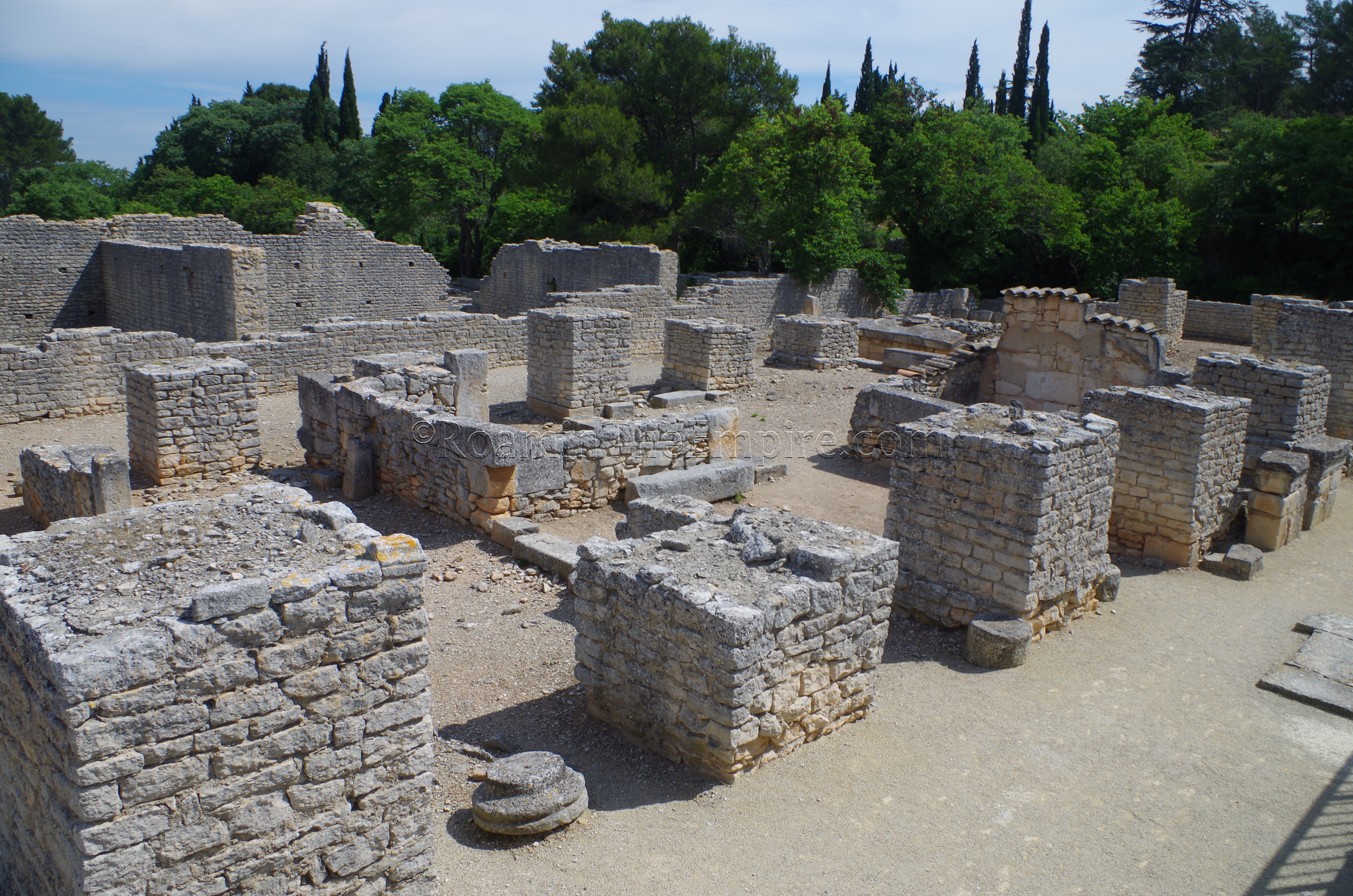
Monumental Area
Further on from the residential area of Glanum to the south is the monumental area, where many of the public buildings or the settlement were located. Immediately south of the bathing complex is what is described as being the curia, or some kind of town council or town meeting place. The building features a distinct apse that faces the cardo maximus. The curia seems to have been built during the latter stages of the second phase of the forum area construction in the early part of the 1st century CE. It may have replaced a Greek bouleuterion that would have occupied the same space in the Gallo-Greek period, though there is no archaeological evidence to confirm its presence there, and the presence of a bouleuterion elsewhere on the site may preclude this.
The curia is attached to the north side of the next building, the basilica. The basilica was constructed around 10 CE, during the second building phase of the forum area and is the largest building uncovered at Glanum. A previous basilica was located further to the south in the area that is now occupied by the open forum area. A few years after the construction of the basilica, the curia was added onto it. The current ground level of the basilica remains are significantly below the pavement level of the adjacent forum pavements. The basilica remains visible, however, are associated with the foundational level of the basilica, and would not have been directly accessible off the forum. In a way, this is fortunate as it has allowed for the preservation of some previously existing buildings that might have otherwise been completely destroyed.
Within the western extent of the basilica, and just outside of the basilica are the remains of a house dating to the first Roman phase of building following the destruction of 90 BCE. The house is called the House of Cornelius Sulla, so named because of an inscription with that name located on a mosaic found in one of the rooms. The house was covered over when the basilica was constructed. In the eastern part of the basilica, the remains of the Tuscan Temple are exposed. The dedication of the temple remains unknown, but it is dated to the Hellenistic period, probably constructed in the 2nd century BCE. Like the House of Cornelius Sulla, the Tuscan Temple was largely razed to make way for construction of the basilica and forum, but once again some of it is preserved here in the foundations of the basilica.
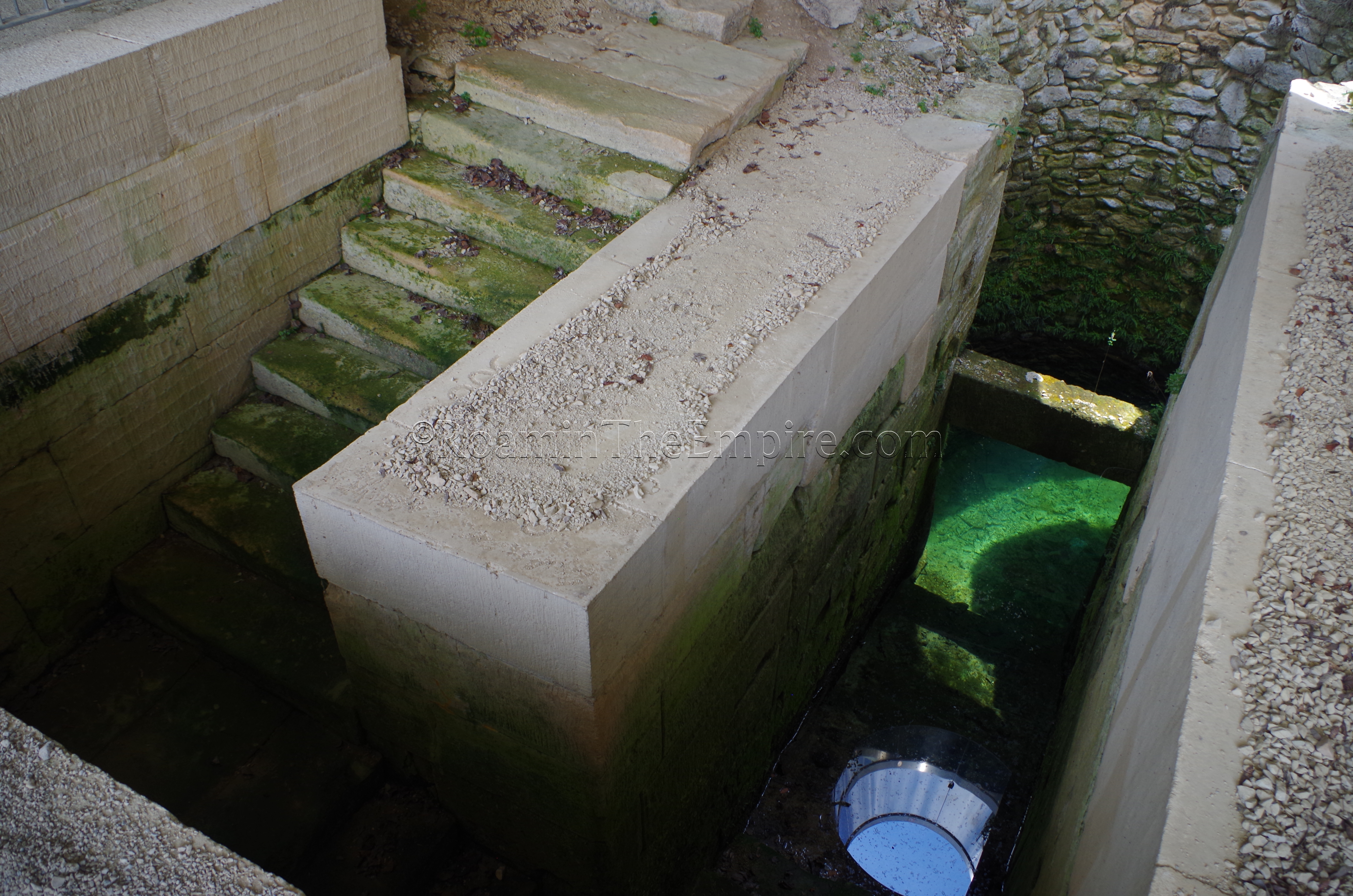
South of the basilica foundations, preserved below the elevated remains of the forum, is the Hellenistic Dromos Well. The Dromos Well was likely associated with the adjacent Tuscan Temple, though, again, the exact nature and dedication of either is unknown. The exterior structures of the well seem to have been destroyed in the destruction of 90 BCE, but the well likely remained in use in a religious/ritual context for nearly a century afterward, until the well was completely covered by the forum. A stairwell and the well itself are preserved beneath the forum and a well head fixture leading to the well remained in the forum during the Roman era, but it doesn’t seem to have served the same function. In late antiquity, when the site was being spoliated for building material, the well was filled in with lesser quality fragments that wouldn’t be of as much use for building material.
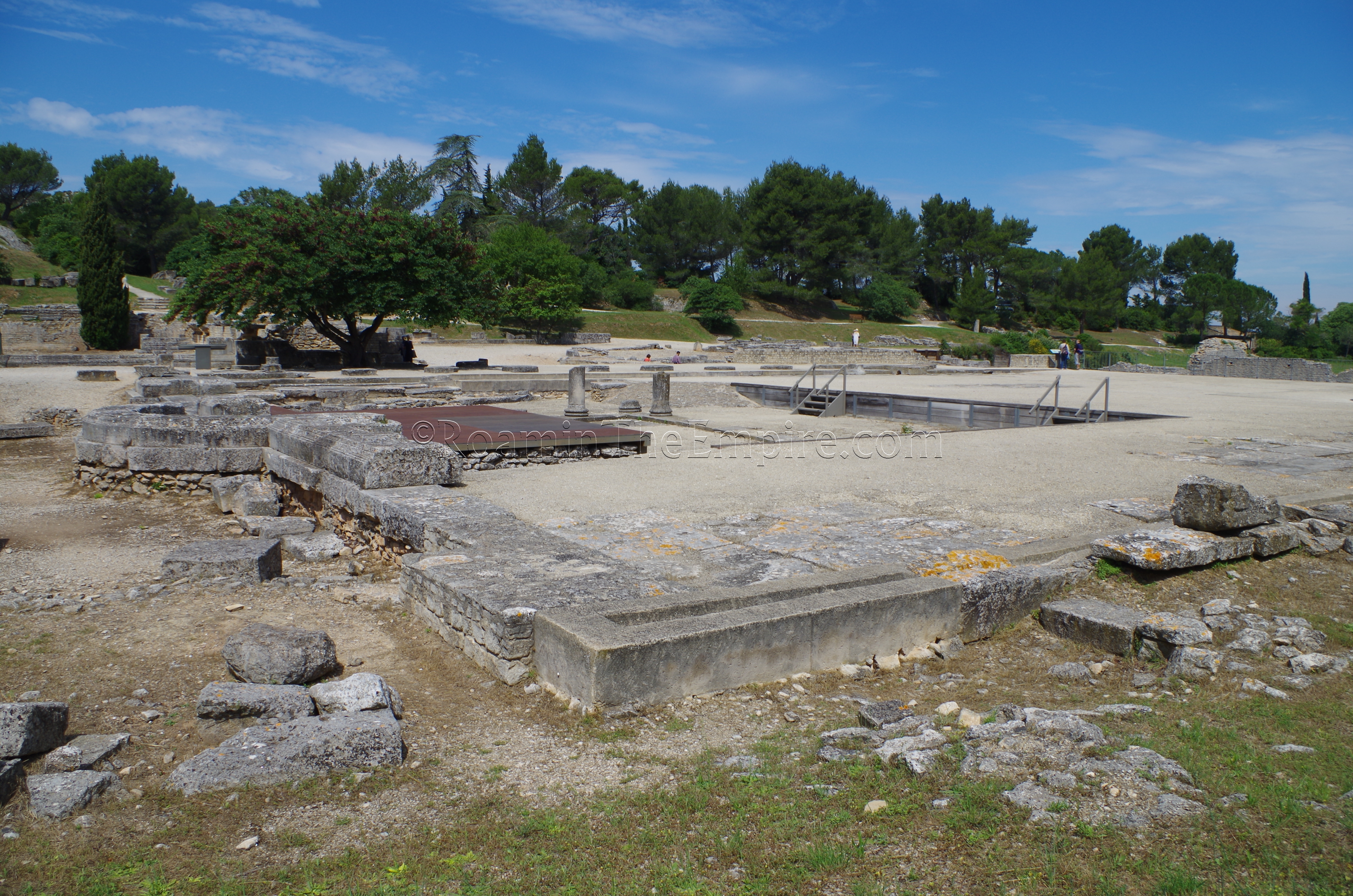
Much of the open area of the forum itself is preserved in form, though only some of the paving stones remain. There are remnants of the porticoes that lined the east and west sides of it from the Augustan period. In the final stages of the second building phase of the forum in the 70-80’s CE, an enclosing wall with an exedra was constructed on the south end of the forum. A section of the southern portion of the forum has been excavated below the forum pavement to reveal some remains belonging to the original basilica constructed around 20 BCE.
Just off the southern end of the forum is a monumental platform that seems to have been constructed in the final years of the 1st century CE. The platform covers over the remains of a well that functioned during the Hellenistic period, and which may have been a feature in a Hellenistic building; perhaps a house but also possibly some sort of public building of ceremonial significance. One author suggest that this may have been a prytaneum, a ceremonial house used for official meetings and banquets related to governmental relations, though there is no archaeological evidence that offers a clear picture of the use of that area prior to the construction of the platform.
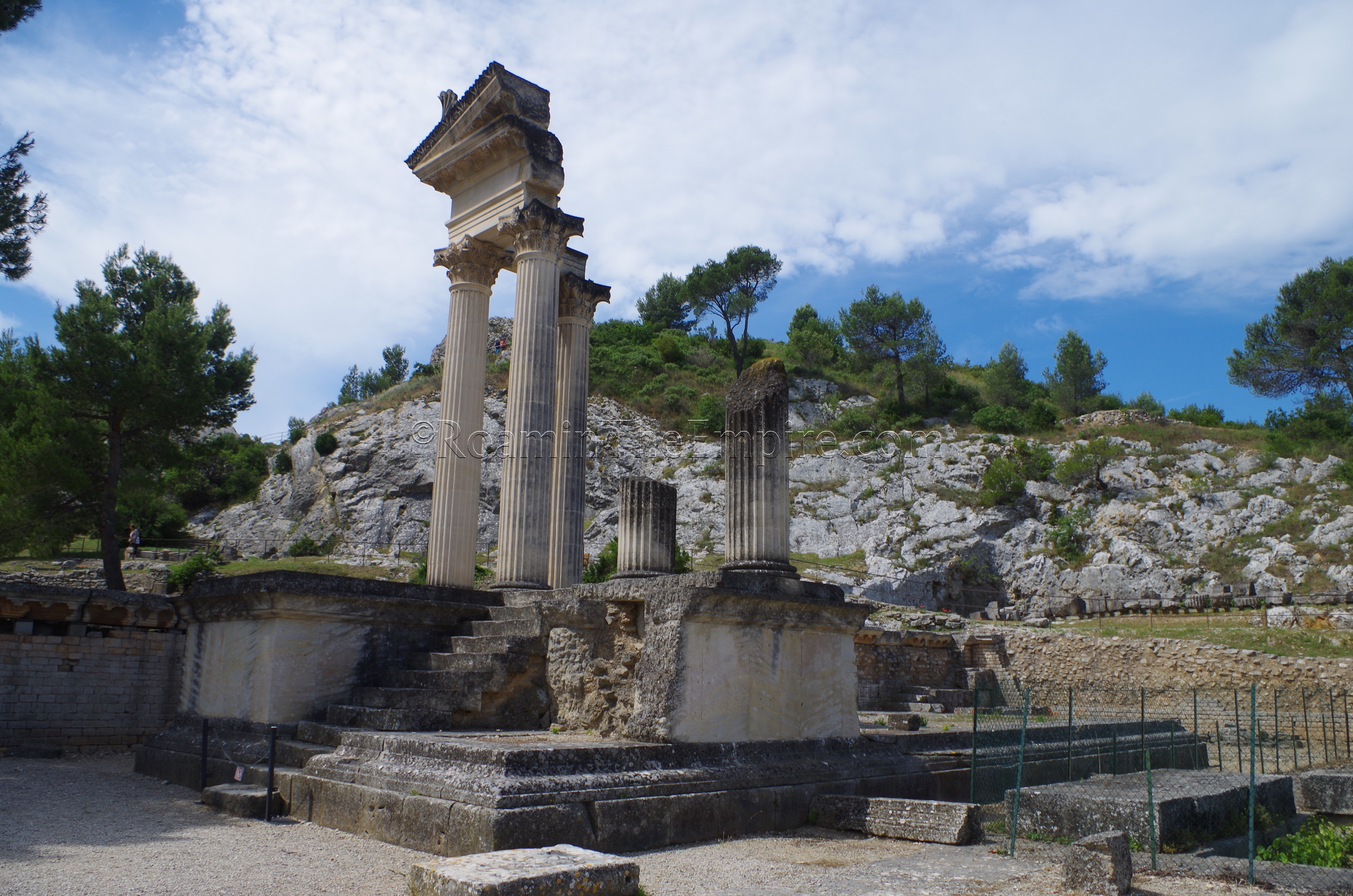
Opposite the monumental platform, on the west side of the cardo maximus (which is not visible through the forum) are the remains of two temples, referred to as the Gemini Temples. Despite the name, they are not identical in form and structure. Surrounding the two temples on three sides is a peribolus, while the temples are exposed to the forum area on the east side. It is theorized that the two temples are dedicated to Augustus’ adopted sons, Lucius and Gaius. The smaller temple on the south side seems to have been constructed about 30 BCE, while the larger temple on the north probably dates a little later to 10 BCE. The peribolus, which cuts into the hillside somewhat, appears to have been constructed at the turn of the 1st century BCE and 1st century CE. The temples were likely originally dedicated to other gods upon their construction, but were then later rededicated for imperial cult purposes. The gods to which the temples may have originally been dedicated is unknown, though it has been suggested that Hercules may have been one of them.
Immediately south of the Gemini Temples are the remains of the earlier Hellenistic bouleuterion. The bouleuterion, which would have served as a meeting place, seems to have been constructed in the 2nd century BCE and used through to the 1st century BCE. The construction of the Gemini Temples, however, necessitated the destruction of the bouleuterion, as the footprint of the Gemini Temples complex overlaps somewhat with the remains of the council house. With the expansion of the forum and the construction of the curia, the smaller bouleuterion would have essentially been obsolete as well. Just further south of this, adjacent to the fortified gateway to the sacred area, is a platform with altars
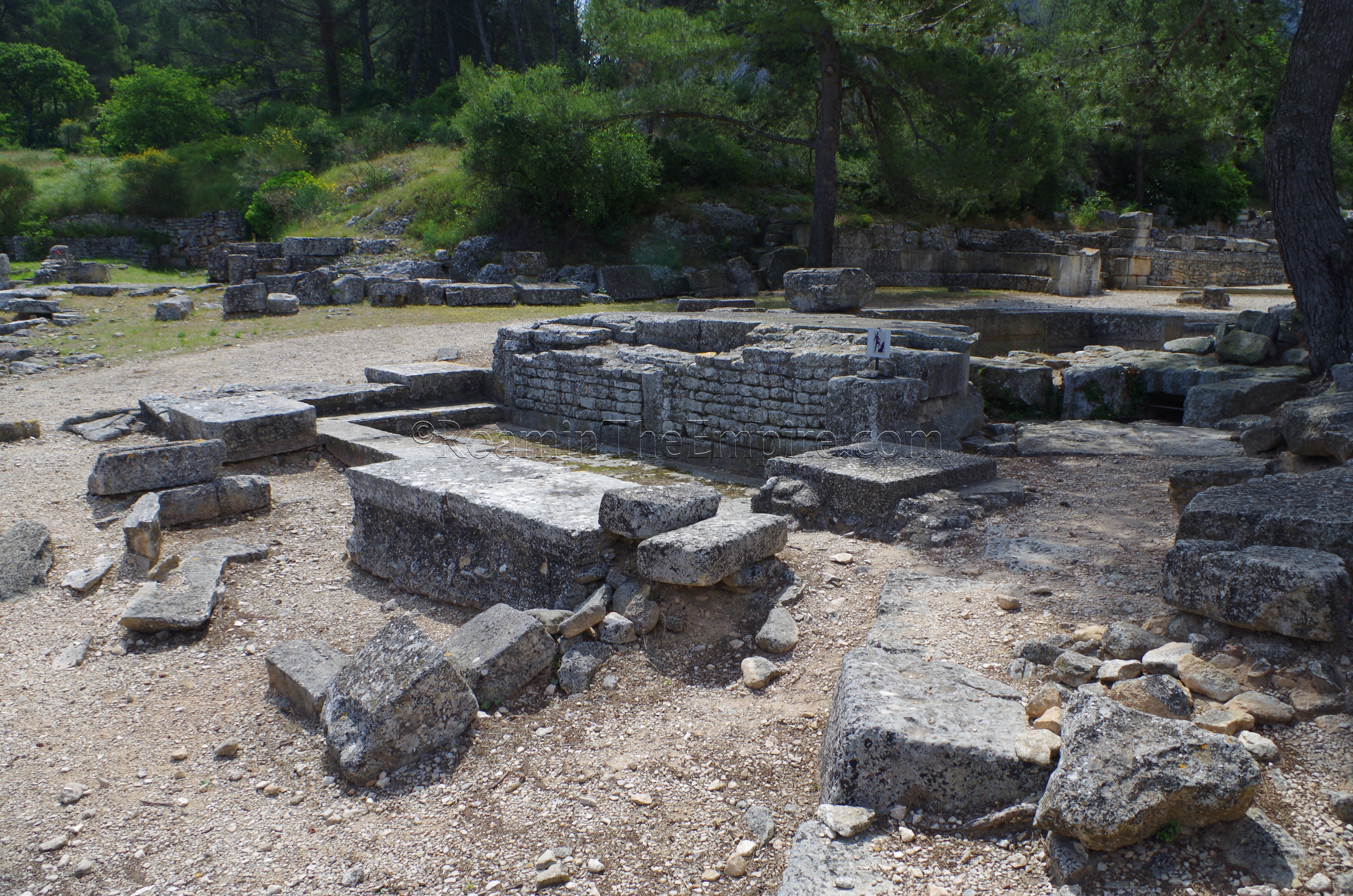
Back across the cardo maximus on the east side are the remains of what is described as a triumphal fountain. The semi-circular fountain seems to have been constructed about 20 BCE and displayed images relating to Roman victory over the Gauls. The semi-circular niche in the fountain also likely held a statue. Prior to the construction of the fountain, during the Hellenistic period, there was a two room building on the site. Though there has not been any archaeological confirmation of the function of the building, it is theorized to have been the treasury of the city. This supposition is based on the typical presence of such a building in Greek cities, and the lack of any evidence of a treasury elsewhere in the public area of Glanum. Adjacent to this area, along the hillside on the eastern edge of the valley are an exedra and portico dating to 70-80 CE. While the structures remaining date to the late 1st century CE, earlier incarnations of the buildings seem to have existed at the location dating back to at least the 2nd century BCE. Due to the discovery of some pillars and lintels adjacent to the portico that had carved niches for trophy heads, it is posited that the portico was perhaps associated with the Gallic practice of displaying trophy heads. The presence of the trophy head displays may also have just been happenstance, with the displays originating elsewhere and being moved there by spoliation activity. Some water basins in the portico suggest that it may have been an area for ritual washing before entering the sacred area.
Sacred Area
At the south end of the portico is a fortified gateway that essentially marks the end of what is described as the monumental area and the beginning of the sacred area. The gateway itself was originally constructed in the Greek period, with some vestiges of the wall around the gate dating to as early as the 6th century BCE, the earliest building period at the site. The western side of the gate was used for car traffic while on the east side there was a postern for pedestrian traffic through the gate. Following the original construction in the 6th century BCE, the gate and adjacent walls were repeatedly renovated and reconstructed through the Greek and Roman periods.
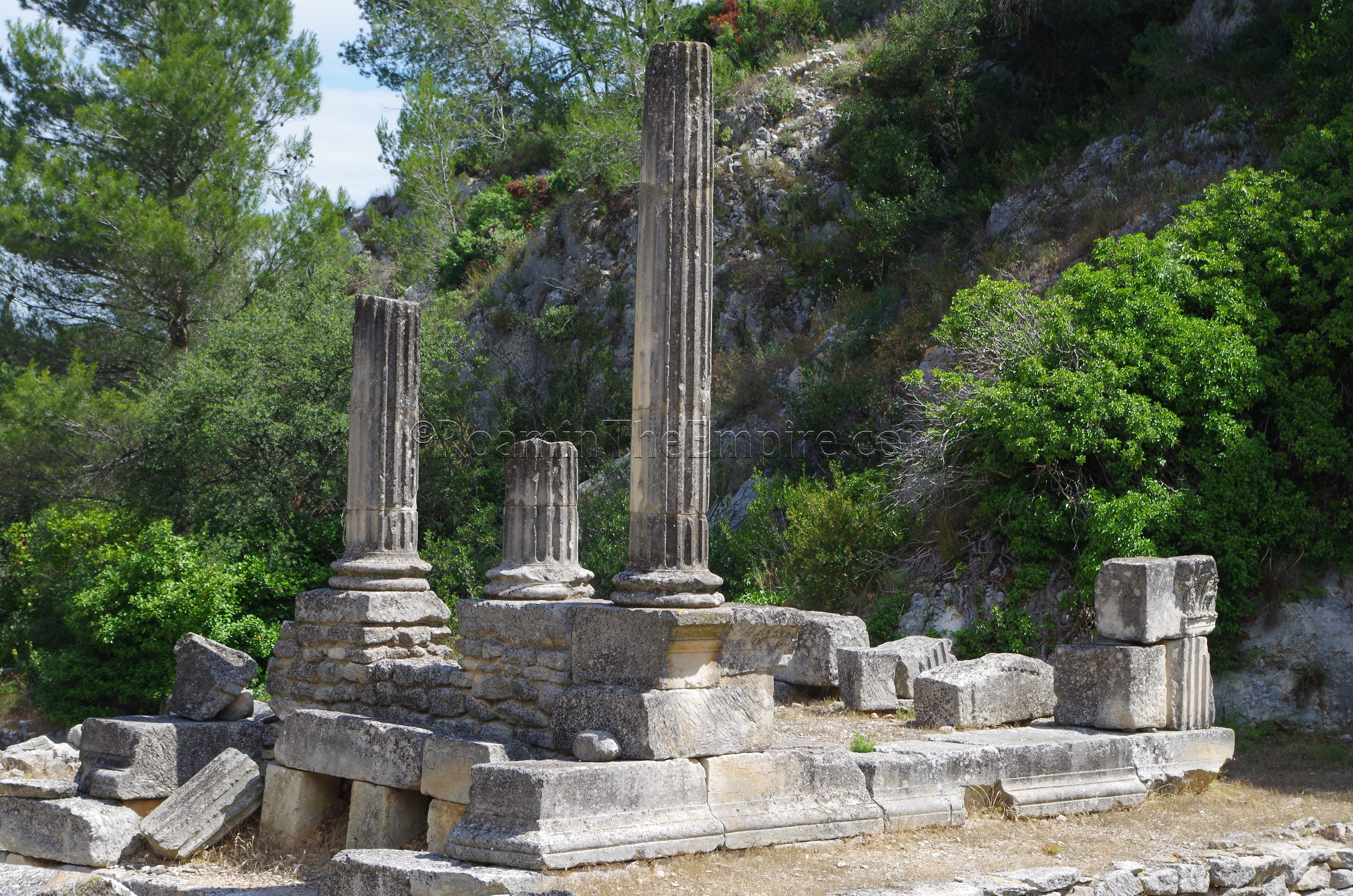
A bit further on south from the fortified gateway, on the east side of the road, are the remains of the Temple of Valetudo. This temple bears an inscription noting its construction by Marcus Agrippa. Agrippa first visited Glanum about 39 BCE and could have commissioned the construction there, but given the building program of the forum in the late 1st century BCE, a date of around 20 BCE seems more likely for the construction of the temple. The Temple of Valetudo likely replaces a small temple to Glanis that would have occupied the same spot. Adjacent to the temple on the south side is the sacred spring associated with Glanis, of which there is a staircase that descends to the spring, still filled with water. The construction of the staircase and associated structures dates to the 2nd century BCE, though the cuts in the rock widening access to the spring date to at least the 6th century BCE. The later Roman association with Valetudo with the spring suggests that the spring itself was believed to have healing or cleansing properties.
Opposite the spring of Glanis is the Salluvian Staircase, a set of stairs leading to a sanctuary in the rock above the site that was associated with the cult of Glanis. There isn’t any access to the sanctuary, but a fair amount of the staircase survives. Adjacent to the staircase were found an inscription in Greek referring to the mother goddess and a Latin inscription to Glanis and Fortuna Redux by a soldier of Legio XXI. A copy (or perhaps the original) of the Glanis inscription is in place on the right side of the staircase.
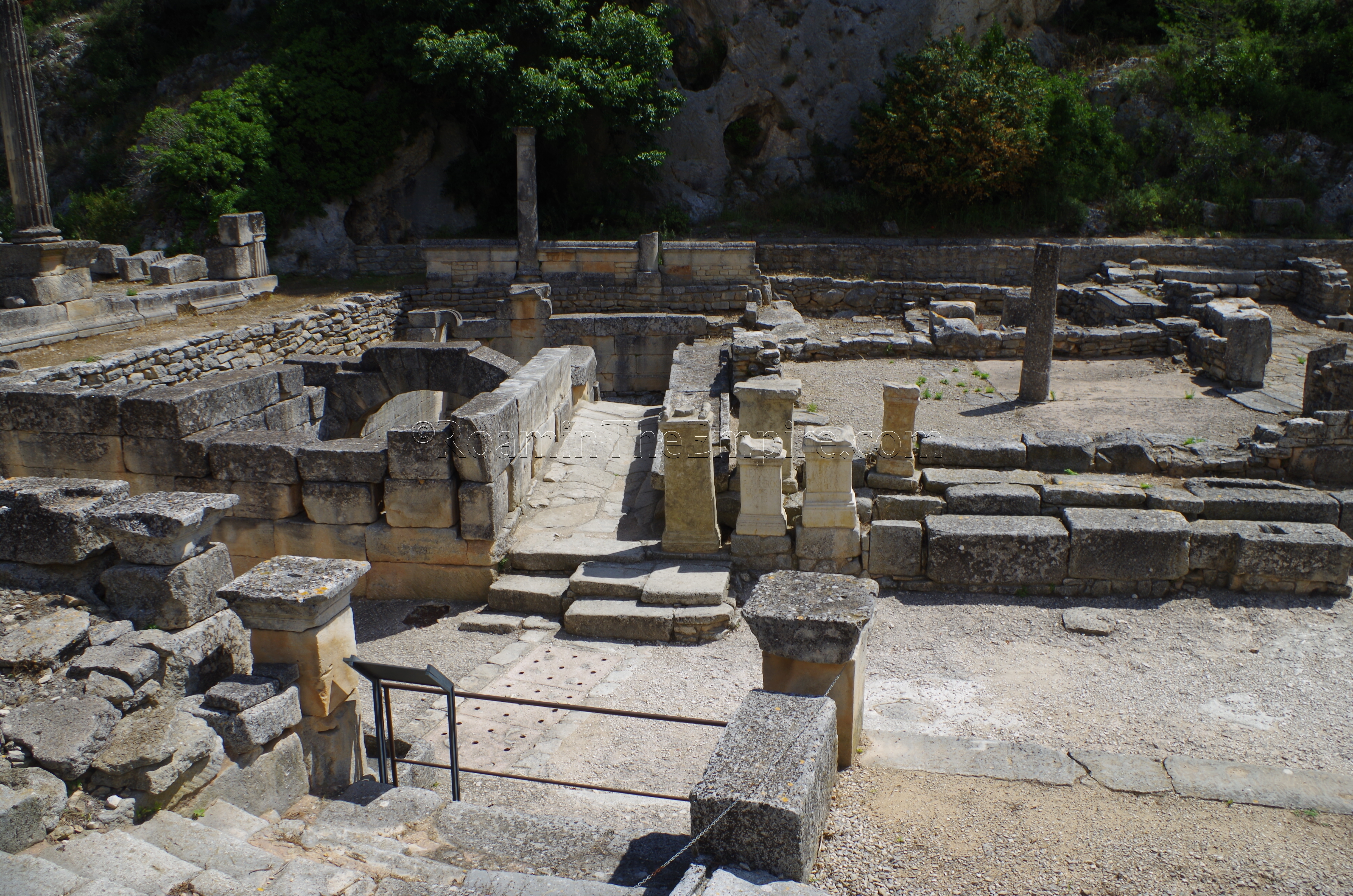
Back on the east side of the road is a shrine to Hercules, where a number of inscriptions dedicated to Hercules were found, and some of which are still in place here. The shrine, like the Temple of Valetudo, dates to the Roman period, though likely replaces an earlier construction of similar use. Much of what remains south of this shrine is largely indistinct houses dating to Gallic occupation of the site, probably before the heavy Greek influence. There is another building of interest here, though. A bit south of the Salluvian Staircase to the south is a building with hypocaust-like tiles stacked in the center of two rooms. Originally believed to be a Hellenistic bathing complex, it now seems to have been wine smoking complex. A staircase near here allows access to a trail that leads to the peak to the west, which offers great views of the site and the surrounding area.
One of the big draws coming to this area of France was the site of Glanum, and it didn’t disappoint at all. It took me nearly 2 hours to get through the site, though more casual observers could probably get through in an hour, perhaps an hour and a half. There are signs posted throughout the site in French, English, and Spanish describing various areas and buildings, often with illustrations outlining various phases of construction for the areas. There’s a lot to like about the site, from its presentation to the actual historical and archaeological implications, and not really much to complain about. I do wish there were more of an on-site museum here, which would do wonders for adding some context, but, it hardly detracts from anything. If given the time and opportunity, Glanum is a site that I would give my highest recommendation to visiting.
Mas de la Pyramide
A little ways to the northeast of Glanum is what is known as the Mas de la Pyramide. This structure is, from what I understand, a vestige from a Roman quarry in the area. Similar to the spire at the El Médol quarry near Tarragona, Spain, it seems to be a means to measuring the depth the quarry had reached. Unfortunately, this monument is located on private property that was inaccessible when I visited. I’ve read some accounts that the owner of the property, on which there may or may not also be some sort of restaurant and workshop, is generally pretty welcoming of tourists wanting to visit, while others have related the opposite. In either case, the gate with access to the property was closed when I visited, so, I had no personal experience. I’ve pinned it on the map because I’m reasonably certain it is there, but unfortunately can’t add my own experience to the mix.
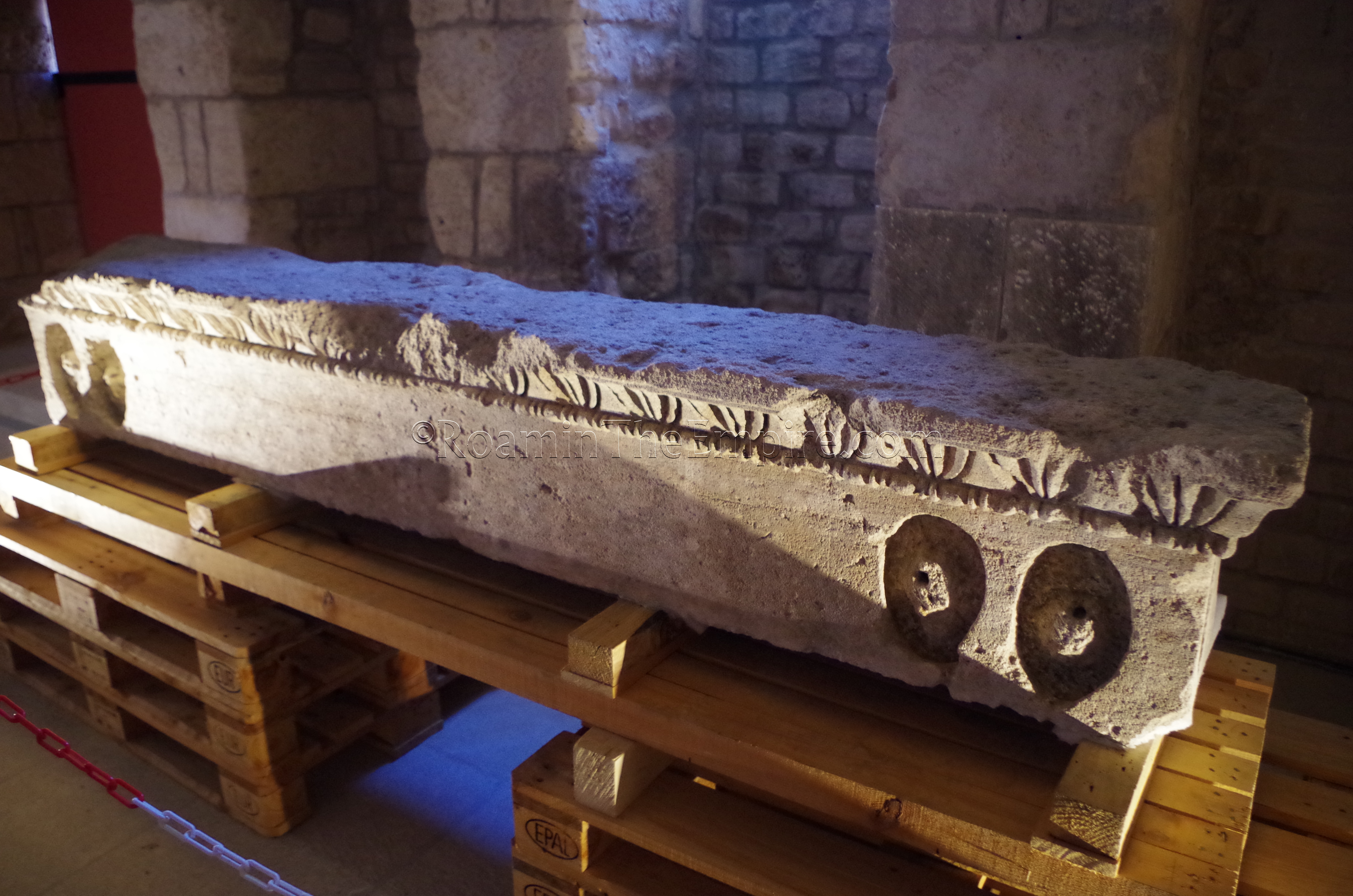
Hotel de Sade
Back in Saint-Rémy-de-Provence is the Hotel de Sade, a small museum with some artifacts recovered from Glanum. Located at Rue du Parage 1, the Hotel de Sade is open every day from June 1st to September 30th between 9:30 and 13:00 and between 14:00 and 18:00. The rest of the year the museum is closed. Admission is 3.50 Euro. A combined ticket with Glanum can also be purchased for 10 Euro.
The museum itself is rather small, in the main room are a few smaller objects like coins and rings, a statue, a couple busts, nine altars, and a relief fragment. The altars are interesting because a few of them are dedicated to local deities like Sucellus. There is also the head of a sistrum that is particularly interesting given its context in Glanum, but, the collection is quite small and there isn’t a whole lot of information posted. There’s also really no information on the individual altars, in particular, some of which aren’t easy to read and identify, which was a bit disappointing. In the courtyard area are the remains of a bathing complex dating to the 4th century CE, after the abandonment of Glanum and the shift in population to the area of Saint-Rémy-de-Provence. There are some signs noting the various rooms of the bathing complex, though not really any contextual information aside from some very general information near the beginning.
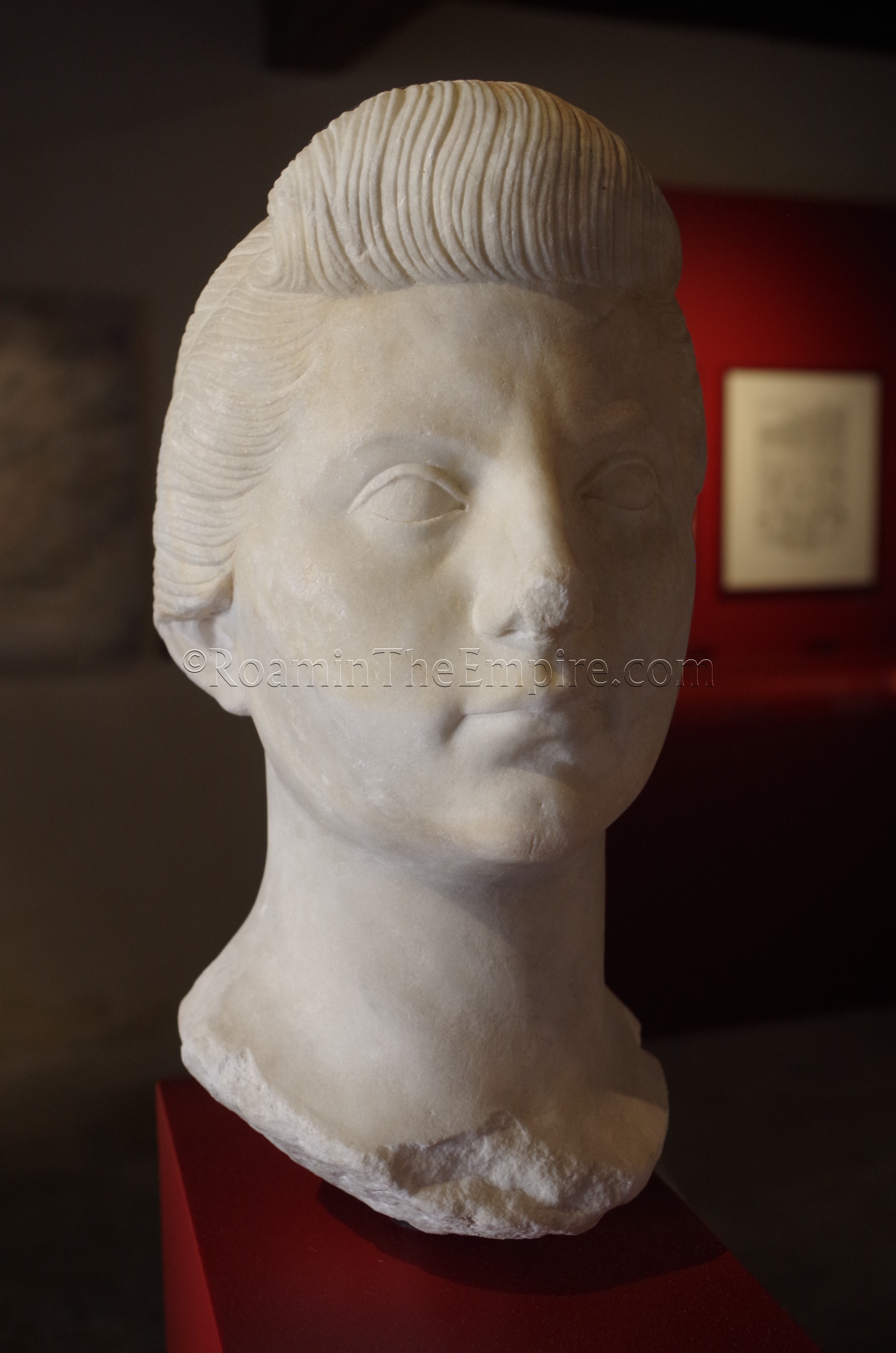
Off the courtyard is another room where some larger objects are on display. There are a few mosaics and some larger architectural pieces. The most interesting piece here, and perhaps the most interesting in the entire museum, is a lintel with carved out niches for the display of head trophies dated to between the 1st and 4th centuries BCE. In all, it took only about 20 minutes to visit the entirety of the museum and the bathing complex, and again, there wasn’t very much information available. There was a panel with some video in the room off the courtyard, with information regarding conservation and some of the pieces in that room. Billed as the collection for the archaeological site of Glanum, it was a little disappointing that there was so little material and that there wasn’t a lot of information on the material available. It’s still a worthwhile visit, if not just to see some of the nicer pieces. I will concede that what is on display is of pretty good quality, but, given how impressive the actual site of Glanum is, the museum was a little disappointing at first glance.
[Not a valid template]Sources:
Bromwich, James. The Roman Remains of Southern France: A Guidebook. London: Routledge, 1996.
King, Anthony. Roman Gaul and Germany. University of California Press, 1990.
Livy, Ab Urbe Condita, 5.34-35.
Pliny, Naturalis Historia, 3.5.
Smith, William. Dictionary of Greek and Roman Geography. Walton & Murray, 1870.
Stillwell, Richard, William L. MacDonald, and Marian Holland. McAllister. The Princeton Encyclopedia of Classical Sites. Princeton, NJ: Princeton U Press, 1976.


